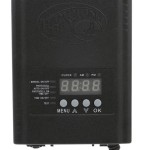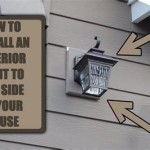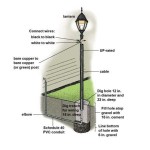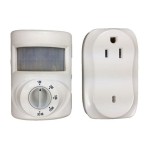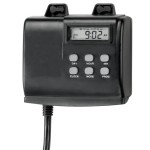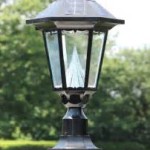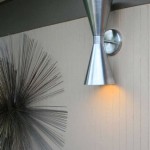Illuminating Your Outdoor Space: A Guide to Outdoor Lighting Fixtures
Outdoor lighting is a crucial element of landscape design and home security. Selecting the right outdoor lighting fixtures can enhance the aesthetic appeal of a property, improve safety, and extend the usability of outdoor spaces during the evening hours. Understanding the various types of fixtures available, their functionalities, and installation considerations is essential for achieving optimal results.
Choosing the correct outdoor lighting involves considering several factors, including the purpose of the lighting, the desired ambiance, the architectural style of the home, and energy efficiency. Strategic placement and fixture selection can transform a dark and uninviting area into a welcoming and secure environment. From highlighting architectural features to illuminating pathways and patios, outdoor lighting offers a versatile and effective means of enhancing property value and enjoyment.
Understanding Different Types of Outdoor Lighting Fixtures
The market offers a wide array of outdoor lighting fixtures, each designed for specific applications and offering unique aesthetic qualities. Understanding these differences is the first step in creating a well-designed outdoor lighting scheme.
*Wall Lights:
These fixtures are mounted to exterior walls and are commonly used to illuminate entryways, garages, and patios. Wall lights can provide both ambient and accent lighting depending on their design and bulb type. Sconces, lanterns, and floodlights are all variations of wall-mounted lighting. Upward-facing wall lights can highlight architectural details, while downward-facing lights provide functional illumination for pathways and doorways. *Path Lights:
Designed to illuminate walkways, driveways, and garden paths, path lights enhance safety and guide visitors through the property. These fixtures are typically low to the ground and emit a soft, diffused light to avoid glare. Path lights are available in a variety of styles, including traditional lanterns, contemporary designs, and solar-powered options. The spacing and placement of path lights are crucial for providing adequate illumination without creating excessive light pollution. *Spotlights and Floodlights:
These fixtures are used to highlight specific features, such as trees, sculptures, or architectural details. Spotlights provide a focused beam of light, while floodlights offer a wider, more diffused illumination. These lights are often adjustable, allowing for precise aiming and control of the illuminated area. Floodlights are also frequently used for security purposes, providing a bright, wide area of illumination to deter intruders. *Deck Lights:
Integrated into decks, patios, and steps, deck lights provide subtle and functional illumination. These fixtures are typically low-voltage and designed to withstand outdoor conditions. Deck lights can be used to define edges, highlight steps, and create a warm and inviting ambiance. Recessed lights, strip lights, and post cap lights are common types of deck lighting. *Landscape Lighting:
Encompassing a variety of fixtures, landscape lighting is designed to enhance the beauty of gardens, lawns, and other outdoor features. This category includes spotlights, path lights, well lights (recessed ground lights), and underwater lights for ponds and fountains. Landscape lighting can create dramatic effects, highlight textures, and extend the enjoyment of outdoor spaces into the evening hours. *String Lights:
String lights, also known as fairy lights or bistro lights, offer a decorative and festive touch to outdoor spaces. These lights consist of a series of bulbs strung along a wire and can be draped across trees, fences, or patios. String lights are available in a variety of styles, including traditional incandescent bulbs, LED bulbs, and decorative shades. They are commonly used to create a relaxed and inviting atmosphere for outdoor gatherings.Key Considerations for Selecting Outdoor Lighting Fixtures
Choosing the right outdoor lighting fixtures requires careful consideration of several factors, including functionality, aesthetics, durability, and energy efficiency. By addressing these considerations, property owners can create an outdoor lighting scheme that meets their specific needs and preferences.
*Purpose and Functionality:
The primary purpose of the lighting should guide fixture selection. Is the goal to provide security, illuminate pathways, highlight architectural features, or create an ambiance for entertaining? Different fixtures are better suited for different purposes. For example, floodlights are ideal for security, while path lights are best for illuminating walkways. Understanding the intended use of each fixture will ensure that the lighting scheme is effective and efficient. *Style and Aesthetics:
Outdoor lighting fixtures should complement the architectural style of the home and the overall landscape design. A wide range of styles are available, from traditional lanterns to contemporary designs. Consider the materials, finishes, and shapes of the fixtures to ensure that they blend seamlessly with the existing aesthetic. Cohesive style choices can significantly enhance the curb appeal of a property. *Durability and Weather Resistance:
Outdoor lighting fixtures are exposed to the elements and must be durable enough to withstand rain, snow, sun, and wind. Look for fixtures made from weather-resistant materials such as stainless steel, aluminum, brass, or high-quality plastics. Check the IP (Ingress Protection) rating of the fixtures to ensure that they are adequately protected against water and dust. Fixtures with a higher IP rating are better suited for harsh weather conditions. *Energy Efficiency:
Energy-efficient lighting options can significantly reduce electricity consumption and lower energy bills. LED (Light Emitting Diode) bulbs are the most energy-efficient option, offering long lifespans and low energy consumption compared to traditional incandescent or halogen bulbs. Solar-powered fixtures are another energy-efficient option, although their performance can vary depending on weather conditions and sunlight exposure. When selecting fixtures, consider the wattage and lumen output to ensure adequate brightness without excessive energy consumption. *Light Output and Color Temperature:
The brightness of a light is measured in lumens, while the color temperature is measured in Kelvin (K). Higher lumen values indicate brighter lights, while lower Kelvin values indicate warmer, more yellow light. Choose the appropriate lumen output and color temperature based on the intended use of the lighting. For example, path lights typically require lower lumen output and warmer color temperatures, while security lights require higher lumen output and cooler color temperatures. Selecting the correct light output and color temperature can create a more comfortable and visually appealing outdoor environment.Installation and Maintenance of Outdoor Lighting Fixtures
Proper installation and regular maintenance are essential for ensuring the longevity and optimal performance of outdoor lighting fixtures. Incorrect installation can lead to safety hazards and premature fixture failure. Regular maintenance can help prevent corrosion, dirt buildup, and other issues that can affect light output and lifespan.
*Professional Installation:
While some outdoor lighting projects can be completed as DIY projects, it is often advisable to hire a qualified electrician for more complex installations, particularly those involving wiring and electrical connections. A professional electrician can ensure that the installation is done safely and in accordance with local building codes. They can also provide expert advice on fixture placement and wiring configurations. *Wiring and Electrical Safety:
When installing outdoor lighting, it is crucial to follow all electrical safety guidelines and local codes. Use appropriate wiring and connectors that are rated for outdoor use. Ensure that all connections are properly sealed to prevent water damage. Consider using a ground fault circuit interrupter (GFCI) outlet to protect against electrical shock. Always disconnect the power supply before working on any electrical wiring. *Placement and Aiming:
The placement and aiming of outdoor lighting fixtures can significantly impact their effectiveness and aesthetic appeal. Place path lights along walkways to provide adequate illumination without creating glare. Aim spotlights and floodlights to highlight specific features or areas, avoiding excessive light pollution. Consider the viewing angles and potential for light trespass onto neighboring properties. Adjusting the aiming and placement of fixtures can optimize their performance and minimize unwanted light spill. *Regular Cleaning:
Outdoor lighting fixtures are exposed to dirt, dust, and other debris, which can reduce their light output and affect their appearance. Clean the fixtures regularly with a soft cloth and mild detergent. Remove any cobwebs, leaves, or other obstructions that may be blocking the light. Periodic cleaning can help maintain the brightness and clarity of the fixtures. *Bulb Replacement:
Replace burned-out bulbs promptly to maintain consistent lighting levels. When replacing bulbs, use the correct wattage and type specified by the fixture manufacturer. Consider upgrading to LED bulbs to improve energy efficiency and extend bulb lifespan. Dispose of old bulbs properly according to local regulations. *Seasonal Inspections:
Conduct seasonal inspections of outdoor lighting fixtures to identify any potential problems. Check for corrosion, damage, or loose connections. Repair or replace any damaged fixtures or wiring. Trim back any vegetation that may be obstructing the light. Addressing these issues early can prevent more serious problems from developing.By carefully selecting outdoor lighting fixtures, paying attention to installation and maintenance, and incorporating energy-efficient technologies, property owners can create an outdoor environment that is both beautiful and functional. The strategic use of lighting can enhance curb appeal, improve safety, and extend the enjoyment of outdoor spaces throughout the year. Investing in quality outdoor lighting is an investment in the overall value and livability of a property.

5 Outdoor Lighting Styles And Ideas Design Inspirations Lights Com Blog

Outdoor Wall Light Lamp Pir Motion Sensor Led Lights Sconce Waterproof Garden Street Lighting Fruugo No

Outdoor Lighting Discover Now Eglo

Outdoor Lighting Cgc Interiors

Outdoor Lighting Fixtures Led Canopy Flood Lights And Wall Packs

Outdoor Lighting Lamps Plus

Stonehouse 3 Light Outdoor Pendant Smooth Broe Lighting Wall Fixtures

5 Outdoor Lighting Styles And Ideas Design Inspirations Lights Com Blog

Lighting At Lumens

Outdoor Lighting Lamps Plus
Related Posts
